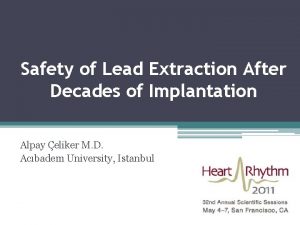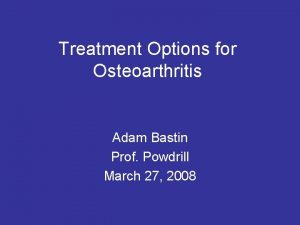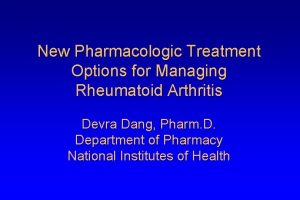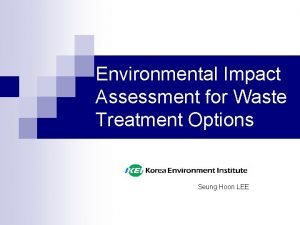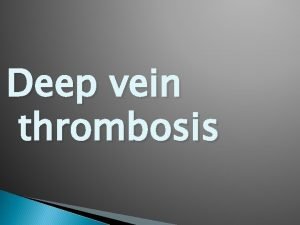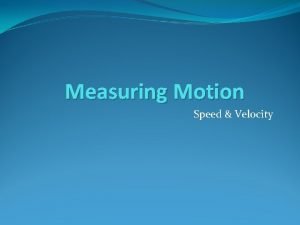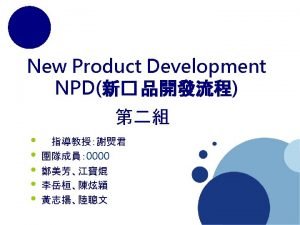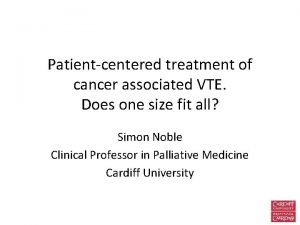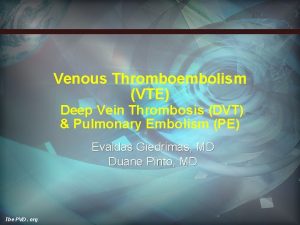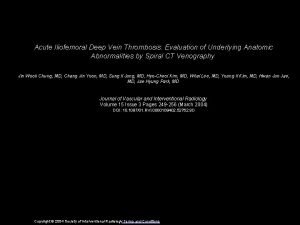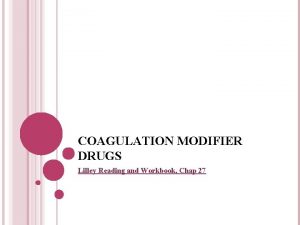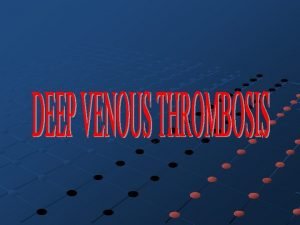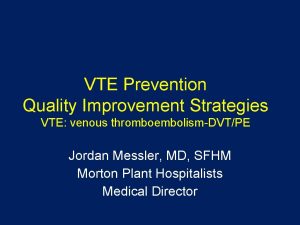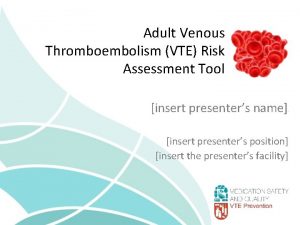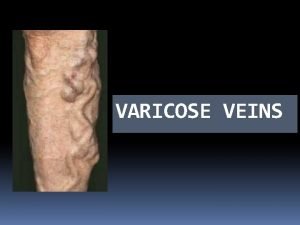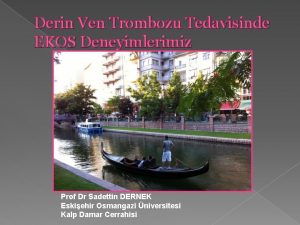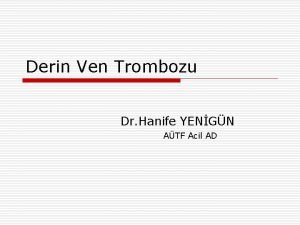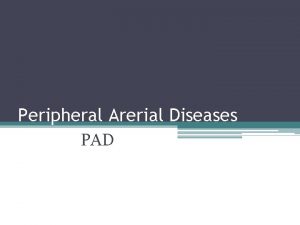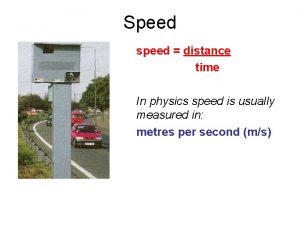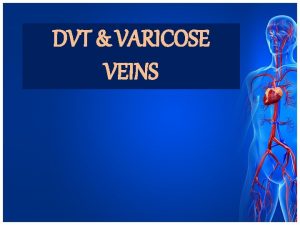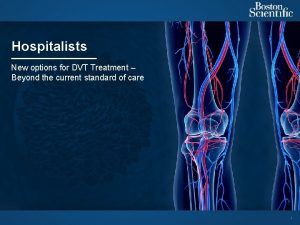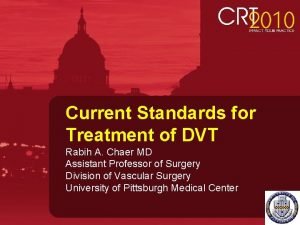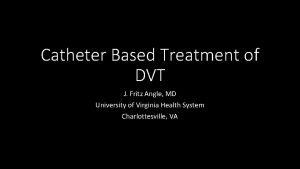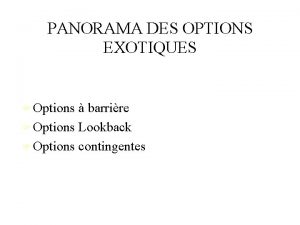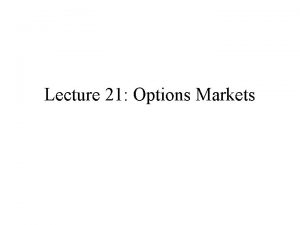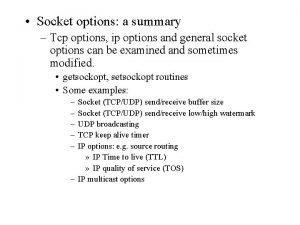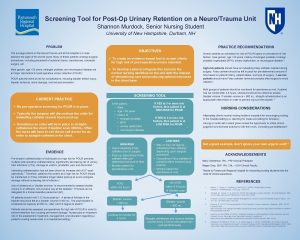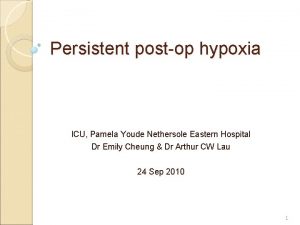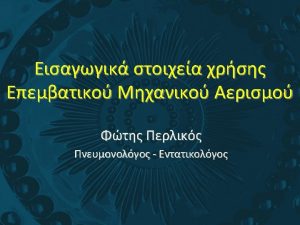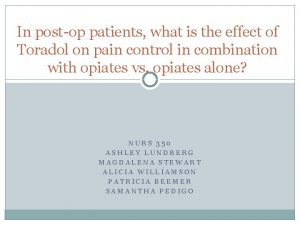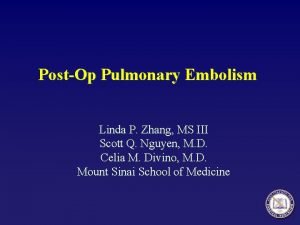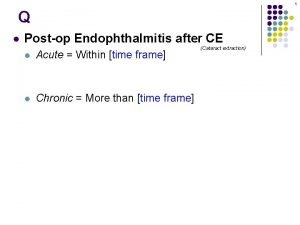TREATMENT OPTIONS FOR DVT PE IN THE POSTOP































- Slides: 31

TREATMENT OPTIONS FOR DVT & PE IN THE POST-OP PERIOD Isabella Mor August 2004

INTRODUCTION n Post-op incidence of DVT varies with type of surgery: q q q n n n 3 -51% with general abdominal surgery 35% with trauma 45 -60% in hip replacement Pulmonary embolus accounts for 3% surgical inpatient deaths 24% of 5477 surgical patients in an autopsy series Mortality 2 – 30% Tai et al(1999)BJS

CASE STUDY n n n Mrs JN, 43 yo Laparoscopic panproctocolectomy for UC Lithotomy position SC heparin on induction No SCDs Long procedure

n Day 3 post op: q q Sudden onset SOB Hypoxia and tachypnoea Tachycardia L calf pain

n ECG

n ABG q q q Fi. O 2 ~1. 0 p. H 7. 5 p. CO 2 31 mm. Hg p. O 2 108 mm. Hg O 2 Sat 100% HCO 3 24 mmol/L

n CXR

n V/Q scan

Establish diagnosis n PIOPED study JAMA (1990); q q n V low, low or high probability VQ scans most valuable Intermediate or non-correlation with clinical picture require more investigation CTPA q Equivalent prevalence of clot detected. Mc. Ewan et al (1999)Australasian Radiology q q Sensitivity 91% Specificity 78%

Pulmonary angiography remains gold standard

n Duplex ultrasound of lower limb veins q q Source of 90% PE Independent indication for treatment >95% sensitive 98% specific

Initial Management n n n Depends on size of embolus and patient’s underlying cardiorespiratory comorbidities Oxygen +/- mechanical ventilation Analgesia for pleuritic pain, avoid opioids IV fluid / inotropic support CVP monitoring & maintenance of high RA pressures

Anticoagulation n n Standard therapy Reduce risk of further PE, does not treat existing clot Allows endogenous thrombolysis High clinical suspicion, start treatment immediately

Heparin n Unfractionated heparin q q q n Infusion or BD dosing to prolong APTT 1. 5 -2. 5 times normal Ability to “turn on & off” Completely reversible with protamine LMWH q q Lower risk of thrombotic & haemorrhagic complications Baglin (2001)Clinical Medicine Suitable for outpatient management

Warfarin n n Start within 3/7 of commencing treatment Paradoxical hypercoagulability in 1 st 24 hr Standard protocol for anticoagulation Target INR 2. 5 q Lowest thromboembolic recurrence & bleeding Baglin(2001) Clinical Medicine

n Risk recurrence without treatment q q n 40% at one month 10% at two months Risk recurrence with anticoagulation q q 17% one week 13% one month 3% three months 2% one year Heit, J Thrombosis&Thrombolysis 2001

Duration of treatment n Research committee of the British Thoracic Society Lancet(1992) q Post-op cohort treatment failure and recurrence was 3% with anticoagulation for 4 weeks or 3 months

Thrombolysis n n n Massive PE Haemodynamic instability Agents: q Streptokinase, urokinase, r-TPA


Thrombolysis n Advantages: q q q n Early improvement in haemodynamic measures Effective in established clot Valve preservation Disadvantages: q q No evidence of long term benefit Four fold increased risk of bleeding Baglin(2001)Clinical Medicine

Thrombolysis n Regional administration q n No improvement in clot resolution TPA + pulmonary endothelium antibody Ding etal(2003)Circulation q q q Monoclonal antibody developed from membrane proteins of pulmonary vascular endothelium of rats In vivo biodistribution showed the ab & it’s conjugate urokinase rapidly and specifically accumulated in lung Compared in rats with pulmonary, hepatic and lower limb emboli n n Efficient thrombolysis in pulmonary model with no change to plasma fibrinogen or bleeding time No thrombolysis induced in the other 2 models

Caval Filter n n Aim to prevent PE Absolute indications: q q n Absolute contraindication to anticoagulation Failure of anticoagulation Relative indications: q q Thrombolysis Proximal free floating thrombus

Caval Filter n n n Temporary or permanent Conical, birds nest, umbrella Temporary filters in perioperative period

Caval Filter n Risks/Complications q q q Filter migration Filter embolism Caval perforation Recurrent DVT/caval obstruction Postphlebitic syndrome Structural failure

Thrombectomy/Embolectomy n n Largely limited to massive thromboembolic events Open approach q q q n Kirschner 1924 Median sternotomy +/- bypass No longer 1 st line - efficient thrombolysis Percutaneous approach q q Transvenous balloon catheter Clot disrupted & retrieved under radiological guidance


Prevention n n Incidence of VTE in post op period underestimated (due to admission/treatment elsewhere) Screening, eg duplex ultrasound lower limb veins not cost effective

Non-pharmacological prevention n Early ambulation Elastic stockings Intermittent pneumatic compression devices

Pharmacological prevention n Low dose unfractionated heparin Low molecular weight heparin Duration q q Should be started pre-op Optimum duration not known

Summary n n PE is a potentially fatal complication of surgery 3% surgical inpatient deaths Anticoagulation mainstay of treatment Prevention is better than cure

References n n n n Baglin, T. Evidence-based Management of Deep Vein Thrombosis and Pulmonary Embolus Clinical Medicine 2001; 1(6): 438 -40 British Thoracic Society Research Committee Optimum Duration of Anticoagulation for DVT & PE Lancet 1992; 340(8824): 873 -6 Ding, BS. , Zhou, YJ. , Chen, XY. , Zhang, J. , Zhang, PX. , Sun, ZY. , Tan, XY. & Liu, JN. , Lung Endothelium Targeting for Pulmonary Embolism and Thombolysis Circulation 2003; 108(23): 2892 -8 Heit, JA. , Perioperative Management of the Chronically Anticoagulated Patient Journal of Thrombosis and Thrombolysis 2001; 12(1): 81 -87 Kaboli, P. , Henderson, M. & White, R. , DVT Prophylaxis and Anticoagulation in the Surgical Patient The Medical Clinics of North America 2003; 87: 77 -110 Mc. Ewan, L. , Gandhi, M. , Anderson, J. & Manthey, K. , Can CT Pulmonary Angiography Replace Ventilation-Perfusion Scans as a First Line Investigation for Pulmonary Emboli? Australasian Radiology 1999; 43: 311 -314 PIOPED study results published Journal of the American Medical Association 1990; 263: 2753 -9 Tai, NRM. , Atwal, AS. & Hamilton, G. , Modern Management of Pulmonary Embolism British Journal of Surgery 1999; 86(7): 853 -868
 Postop fever
Postop fever Treatment options
Treatment options Treatment options
Treatment options Treatment options
Treatment options Bespoke treatment options
Bespoke treatment options Description of waste
Description of waste Bihar veterinary university
Bihar veterinary university Pratt test dvt
Pratt test dvt Velocity magic triangle
Velocity magic triangle Dvt evt mvt
Dvt evt mvt Dvt risk factors
Dvt risk factors Speed distance time triangle
Speed distance time triangle Site of dvt
Site of dvt Dvt ct
Dvt ct Antifibrinolytic drugs
Antifibrinolytic drugs Phlegmasia alba dolens definition
Phlegmasia alba dolens definition Rogers score dvt
Rogers score dvt Anevrizma
Anevrizma Dvt risk factors
Dvt risk factors Formula distance time speed
Formula distance time speed May kuster perforator
May kuster perforator Perforators of leg
Perforators of leg Derin ven trombozu tedavisinde yenilikler
Derin ven trombozu tedavisinde yenilikler Dvt ayırıcı tanı
Dvt ayırıcı tanı Nursing interventions for dvt
Nursing interventions for dvt Distance = speed
Distance = speed Dvt risk factors
Dvt risk factors Rle dvt
Rle dvt Strategi för svensk viltförvaltning
Strategi för svensk viltförvaltning A gastrica
A gastrica Egg för emanuel
Egg för emanuel Fr formel
Fr formel
